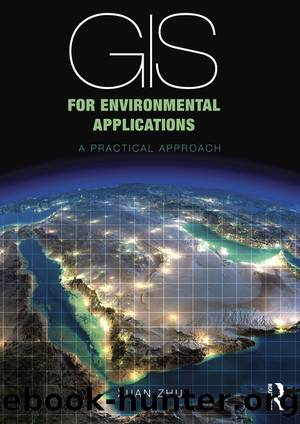GIS for Environmental Applications: A Practical Approach by Xuan Zhu

Author:Xuan Zhu
Language: eng
Format: epub
Publisher: Swales and Willis
Published: 2016-07-14T16:00:00+00:00
Figure 6.1 Electromagnetic wave.
Figure 6.2 Electromagnetic spectrum and atmospheric windows (adapted from Lillesand et al. 2008).
Before electromagnetic radiation from the Sun reaches the Earth’s surface, it has to travel through some distance of the atmosphere, where it interacts with particles and gases. This interaction with the atmosphere occurs mainly through the mechanisms of scattering and absorption. Atmospheric scattering deflects the radiation from its path, and can severely reduce the information content of remote sensing data to the point that the imagery loses contrast and it becomes difficult to differentiate objects. Atmospheric absorption causes molecules in the atmosphere to absorb energy at various wavelengths. Ozone, carbon dioxide and water vapour are three main atmospheric constituents which absorb electromagnetic radiation. Remote sensing is difficult in those regions of the spectrum that are severely affected by atmospheric scattering and/or absorption. We only use the areas of the spectrum that are relatively, though not completely, unaffected by absorption and scattering for remote sensing data acquisition. These spectral regions are called atmospheric windows. In Figure 6.2, the percentage of incoming electromagnetic radiation through the atmosphere is plotted against wavelength. Atmospheric windows are those spectral regions in which the transmission of radiation through the atmosphere is high.
Electromagnetic radiation that is not absorbed or scattered in the atmosphere can reach the Earth’s surface and interact with water, soil, vegetation and other ground features. When electromagnetic radiation is incident on the Earth’s surface, it will interact with the surface features in one or more of the three ways: absorption, transmission and reflection. Remote sensing data are mainly measurements of the radiation reflected from targets. The reflectance characteristics of ground features depend on the wavelength of the incident energy, and the material and condition of these features. It may be quantified by measuring the portion of the incoming radiation that is reflected, which is referred to as spectral reflectance.
Spectral reflectance of a particular ground object usually varies with wavelength. A graph of the spectral reflectance of an object as a function of wavelength is called a spectral reflectance curve. Figure 6.3 shows three spectral reflectance curves respectively characterising typical spectral responses of vegetation, soil and clear water over the visible and near infrared bands. It illustrates that healthy vegetation strongly absorbs radiation in the red and blue bands, but reflects green radiation in the visible band, which is why healthy vegetation appears green to human eyes. When we move from the visible to the near IR region at about 0.7μm, the spectral reflectance of healthy vegetation rises sharply. If our eyes were sensitive to near IR, trees would appear extremely bright to us at these wavelengths. Figure 6.3 also shows that the spectral curves of clear water, soils and vegetation have different shapes. This indicates that these features can be separated spectrally, and therefore can be distinguished in remote sensing imagery of certain bands. For example, water and vegetation may reflect somewhat similarly in the visible region, but are almost always separable in the near IR band, thus a near IR image can be effectively used to discern water and vegetation.
Download
This site does not store any files on its server. We only index and link to content provided by other sites. Please contact the content providers to delete copyright contents if any and email us, we'll remove relevant links or contents immediately.
| Acoustics | Bridges |
| Earthwork Design | Environmental |
| Fire Science | Highway & Traffic |
| Hydrology | Remote Sensing |
| Seismic Design | Structural |
| Structural Dynamics | Surveying & Photogrammetry |
| Transportation |
Whiskies Galore by Ian Buxton(41489)
Introduction to Aircraft Design (Cambridge Aerospace Series) by John P. Fielding(32855)
Small Unmanned Fixed-wing Aircraft Design by Andrew J. Keane Andras Sobester James P. Scanlan & András Sóbester & James P. Scanlan(32534)
Craft Beer for the Homebrewer by Michael Agnew(17902)
Turbulence by E. J. Noyes(7660)
The Complete Stick Figure Physics Tutorials by Allen Sarah(7097)
Kaplan MCAT General Chemistry Review by Kaplan(6547)
The Thirst by Nesbo Jo(6405)
Bad Blood by John Carreyrou(6245)
Modelling of Convective Heat and Mass Transfer in Rotating Flows by Igor V. Shevchuk(6200)
Learning SQL by Alan Beaulieu(5994)
Weapons of Math Destruction by Cathy O'Neil(5779)
Man-made Catastrophes and Risk Information Concealment by Dmitry Chernov & Didier Sornette(5590)
Digital Minimalism by Cal Newport;(5324)
Life 3.0: Being Human in the Age of Artificial Intelligence by Tegmark Max(5144)
iGen by Jean M. Twenge(5125)
Secrets of Antigravity Propulsion: Tesla, UFOs, and Classified Aerospace Technology by Ph.D. Paul A. Laviolette(4860)
Design of Trajectory Optimization Approach for Space Maneuver Vehicle Skip Entry Problems by Runqi Chai & Al Savvaris & Antonios Tsourdos & Senchun Chai(4806)
Electronic Devices & Circuits by Jacob Millman & Christos C. Halkias(4698)
